

A tour of the confinement-crate hog production system
Humans have a long and varied history with hogs. Some, like ancient Egyptians, raised hogs in small pens like we do today. In the British colonies now referred to as the American South, hogs were let loose in the woods so that they could find their own food and water. The farmer would then search for them once or twice a year, picking some for harvesting and leaving some to breed. In 19th century New York there were “street hogs” that roamed the streets, consuming trash they found along the way. For instance, a butcher might throw the remains of his carcass behind the shop, knowing the hogs would reduce the carcass to mere bones. In Egypt today, the Christians separate food scraps from the city’s discarded trash and feeds it to their pigs.(N1,O1)
Although hogs can be raised in many different ways, the vast majority of U.S. swine producers use a virtually identical system, one I refer to as the confinement-crate system. In our pursuit of understanding modern agriculture, we will visit such a farm. We will ask the question: what would your life be like if you were born a female piglet on such a farm.
Overview of farm
For pigs not reserved for breeding, they will go through three stages on the farm: the farrowing, nursery, and finishing stage (as shown below). The females reserved for breeding will be housed in gestation-crates or farrowing-crates. At all of these locations in the swine production process, the swine will be inside a temperature controlled building. The floor will be hard (often concrete or metal) with slats so that the animals’ manure and urine can fall through the floor and kept separate from the animals, thereby preventing the spread of sickness. The walls will be sturdy, and animals will be kept in small groups. The pens are barren, with nothing for the hogs to dig in or explore. At most, a chain may be present for them to chew on, or a ball to roll around.

This is called a confinement system because the animals are kept indoors at all times. As we will see, in regards to animal welfare, there are advantages and disadvantages to such a system. It provides relatively high levels of welfare according to the function-based school of animal welfare (see page 113 of Agricultural and Food Controversies), as it keeps the animal in good health. By remaining inside, the animals do not come into contact with feces of wild animals, and the slatted floors prevent the spread of parasites and disease. This improves animal health and may enhance food safety (see this article for more information on the relationship between animal welfare and food safety).
One shouldn’t underestimate the benefits of keeping hogs on slatted floors. Compared to 70 years ago, when hogs would be kept on the ground or mulch, lungworms used to infect 50% of hogs, but today only infect 11%. Most hogs in 1940 had kidney worms, but very few do today. Trichenella, a parasite that can infect humans if they eat undercooked pork, used to scare us into overcooking pork, whereas it is basically a non-issue today.(N1)
The swine are fed highly nutritious feed, scientifically designed to match their exact nutrients needs for their age and weight. More thought and care goes into designing animal feed than the meals the farmer feeds her family!
The disadvantages of the confinement system are probably obvious. Swine are curious, intelligent animals, but there is nothing for them to do in the barren pens. The swine are biologically fit, but have nothing to do. Why don’t the farmers let the pigs outside? There are many reasons, one of these being to reduce the spread of parasite and disease. Hogs are also difficult to handle, and so bringing them in and out of the barns each day is laborious. You could let hogs outside to play, but hogs are destructive creatures. They will take a verdant pasture and make it look like a World War I no-man’s-land in a matter of days. Fencing them in a pasture is difficult, as they constantly look for weaknesses, and when found, they will escape, though they usually come back when it is feeding-time. There are a number of other reasons swine are kept indoors, as we will see when it is time for a sow to give birth.
That said, let us now tour the farm, starting with your birth as a female piglet—what the hog farmer calls a “gilt”.
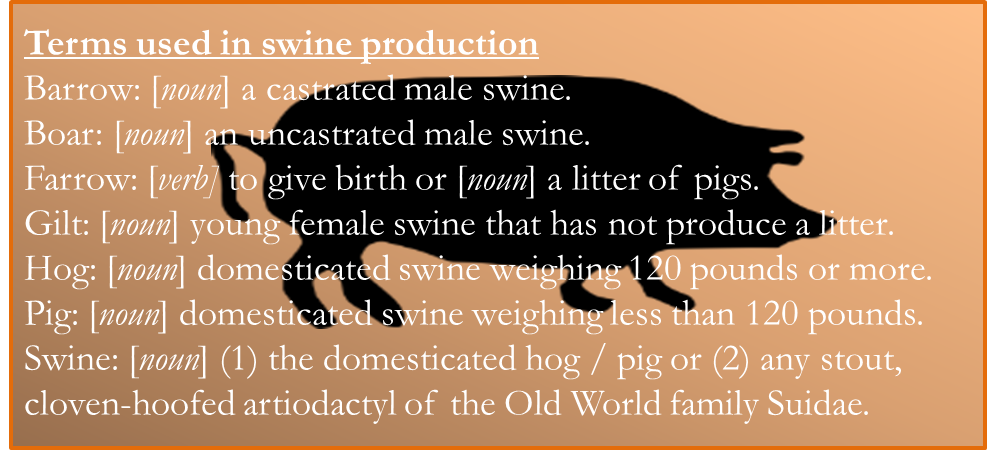
The farrowing stage

You are born a female piglet, along with eleven siblings. Able to walk as soon as you are born, you find your way to your mother’s teat, and begin nursing. After eating, you leave your mother and become cold, but naturally find your way to the heat lamp (or heated pad). Regardless of whether your mother wants to care for you, because she is in a farrowing-crate, she must. Almost every time you want to nurse, you can, for your mother’s crate is only slightly bigger than herself. She cannot leave. She cannot even turn around. Much of the time she is lying down. If sows are kept in pasture systems some of them will choose to abandon their offspring, but because the crate prohibits your mother from leaving you, you need not worry about that. Even if your mother doesn’t want to nurse you, any time she lays down she cannot stop you from feeding.
Figure 1—Sow in a farrowing crate nursing her piglets
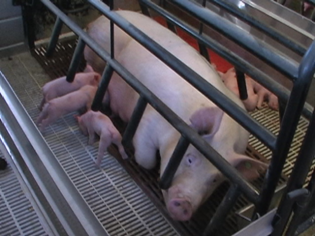
One of the biggest advantages of the farrowing-crate stems from its compactness. It is so small that when your mother chooses to lie down, she must do so gingerly, giving you plenty of room to get out of the way of her large body. Without this crate, there is a good chance you would die as your mother lies down haphazardly, crushing you. Even with the crate system the mortality rate among your siblings is about 10%, but if the litter was raised in a pasture system without the crate to protect them from being crushed, that rate can be as high as 30%.(N1,N4)
Although the floors are hard, there is a soft mat near the heat lamp. At first you have everything you could want. As you grow older, though, you desire to explore, dig, and play, but there isn’t much to do in the confinement-crate system. There is no bedding in which to dig, no new areas to explore. The only thing you lack, then, is relief from boredom.
Before you are weaned a few procedures will be performed on you. Piglets are born with little iron stores in their body. If you were raised outdoors you would get the extra iron by contact with the soil. Since you are raised on concrete, the farmer gives you this extra iron in the form of a shot.
Being a female, you need not worry about castration, but your brothers do, and they will have their testes cut off with no anaesthetic, but perhaps a shot of antibiotics to prevent infection. The farmer needs to assign you an identification number, and she will do so by cutting notches in your ear in a way that spells out a string of letters. Finally, your tail is docked. It hurts, but is less painful than having other pigs bite your tail in the finishing stage of production. Most hog producers used to cut the needle teeth of piglets, so that they can’t injure their mother’s teat while nursing or hurt their siblings when playing. It is my understanding that this practice is increasingly rare.
Figure 2—Dr. Norwood’s selfie with a pig (notice the notches in its ear, used as an identification)
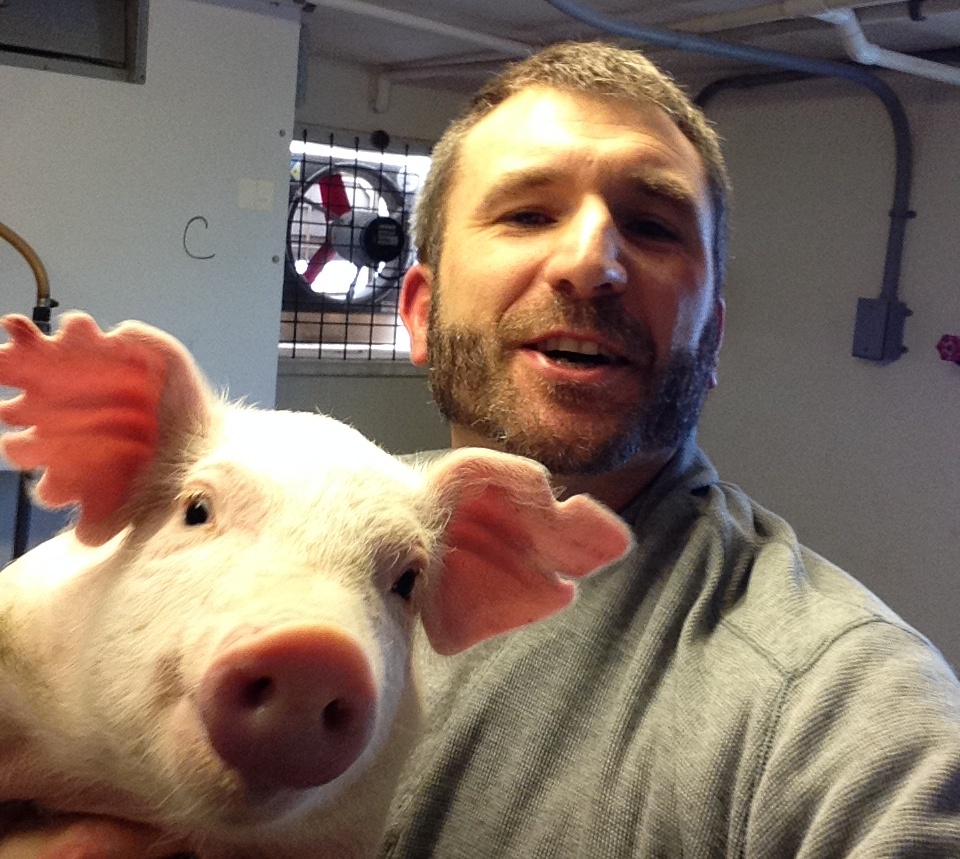
The nursery stage

You were not ready to be weaned at three weeks. Under natural conditions you would have been much older, but the sooner you are weaned the sooner your mother can be bred again and give birth to another litter. Quickly, you are moved to a building they call the nursery, and are placed in a pen with your siblings and other pigs of a similar age. The building smells different than the farrowing crate. That is because it was completely depopulated of piglets before your arrival and sanitized thoroughly. Likewise, right after you leave it will be cleaned and sanitized before a new group enters, which is why they refer to this as an “all-in, all-out” system.
Being at a young age, and under the stress of an early weaning, your immune system is vulnerable, yet because of the care taken by the farmer to sanitize the building, and because of the antibiotics in your feed and the feed’s high nutrient content, you are unlikely to experience poor health. The feed must be designed with great care to transition you from mother’s milk to an all-grain diet, but the science of pig nutrition is nearly perfected. While in the nursery, you may experience four different diet formulations. The feed is tailored to your specific age and weight, but the feed for all the hogs consists mostly of corn and soybean meal with various supplements like minerals, vitamins, and amino acids. Antibiotics are usually added to the hogs’ feed or water from the time they begin eating grain until they are 100 lbs in weight. By not using antibiotics when the hogs reach 100 lbs we ensure no antibiotic residues will be found on pork meat.(I1)
Figure 3—Pigs in the nursery stage of production
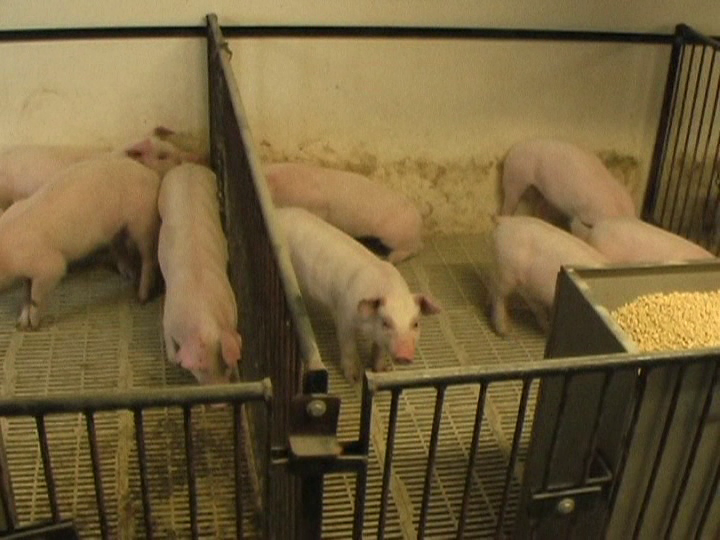
The pen has hard slatted floors and is barren, except for perhaps a few toys, like a chain to chew on or a ball to roll. Although you miss your mother’s milk there is unlimited feed, and you love the way it tastes. As with the farrowing crate, your only lacking need is relief from boredom. There is nothing to do in a small barren pen. There is one thing you miss from the farrowing-crate: a soft mat. Here in the nursery there is nothing comfortable to lie on, but that is to ensure that you and your pen-mates have minimal contact with manure.
Finishing stage

If you were not being reserved for breeding you would be sent to the “finishing floor”, the last stage of production before you are harvested, but even if you remained on the farm for breeding the next stage of your life would be about the same as the finishing stage. After being in the nursery for six weeks—where you have now reached nine weeks of age and weigh about 60 lbs—you will be sent to the finishing floor, which isn’t so much of a floor as it is a building. Led into the barn for the first time and directed to your pen, it will seem nearly identical to the nursery. A hard, slatted floor throughout. A trough with unlimited feed. Hard walls. Perhaps a chain or ball to play with, but nothing more. It differs from the nursery in that it is bigger, and you are with a larger group of hogs.
Figure 4—The finishing floor
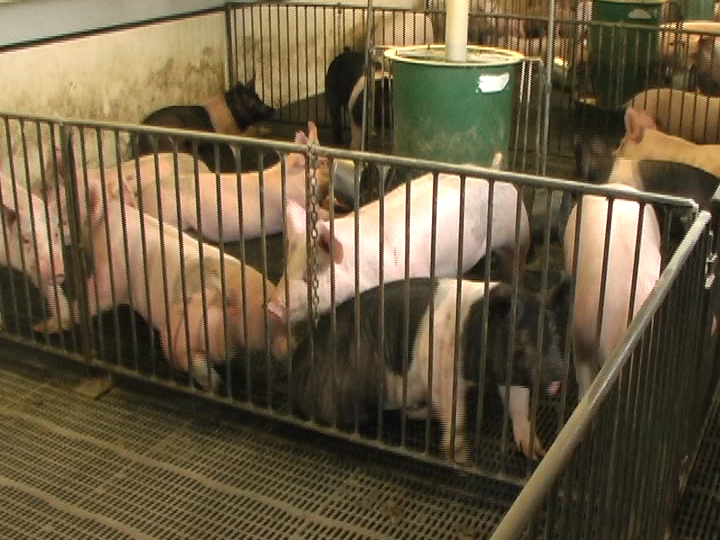
Although bored, you are in fine health, for your feed is nutritious, the barn is clean and the antibiotics added to your feed help you stay healthy (and grow faster). It is a good thing your tail is docked, or your pen-mates would always be nibbling your tail out of boredom (and you would be biting the tails of others, for you are bored too).
As you and your pen-mates grow, unless you are sent to bigger pens, you will have less and less space to move around. Just before slaughter your body will take up approximately five square feet of space, whereas the square feet per pig in your pen is only eight.
Then, for males and the gilts not reserved for breeding (very few males are needed for breeding), comes the day after which there will be no more boredom. At almost half-a-year old and 275 lbs, you will be taken from your home and slaughtered for meat, providing about 150 lbs(O1) of retail pork—enough to feed three typical Americans for a whole year.
First conception and gestation

In this hypothetical life you are a female reserved for breeding. At the age your brothers are slaughtered, you are nearly a fully-grown pig, but you will still be called a gilt until you give birth. At around 32 weeks of age you will be bred for the first time. You may be bred to a live boar, but it is more likely you will be artificially inseminated, which is the farmer’s way of making sure your offspring have genes for fast growth and high felicity. Because you are the product of such a boar, you will conceive quickly and give birth to a litter of ten to twelve piglets. After your first litter is weaned, you will quickly conceive and then begin your second gestation.
Figure 5—Gestation Crate
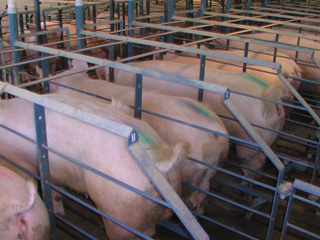
Once you have conceived, you have three months, three weeks, and three days until you give birth, during which you must spend in a gestation-crate—the most controversial aspect of modern hog production. Being in an individual crate, the farmer can give you the precise nutrients you need, in the amounts appropriate for your size. When younger you were allowed all the food you could eat, but now that you are bigger, doing so would compromise your health. Sows can become cruel at feeding time. The dominant sow will eat quickly and then proceed to take other sows’ food also. This means that the dominant sows will eat too much and the subordinate sows will eat too little. By feeding you in an individual pen this isn’t a problem for you. Although sores might appear on your skin due to the hard floor, injury from other animals will not happen, no matter how cruel the other sows may be.
Because sows are healthier inside a temperature-controlled building, the farmer wants to fit as many sows as possible under one roof. Packing sows too tightly causes them to fight among one another, and so gestation-crates are also used so that farmers can house many sows under one roof without having them hurt one another.
Another reason farmers use gestation-crates is convenience. Handling hogs is difficult, time-consuming work, so if you wish to move a group of hogs out of an open lot and into pens for a vaccination, you may need to set aside a large chunk of time. Gestation-crates eliminates the need to round-up and move hogs. You just take your needle, walk to the gestation-crate, and give her a shot. With convenience comes lower labor costs, and lower pork prices.
The problem you face in the gestation-crate is the same problem you will encounter throughout your life: boredom and hard floors. The crate is barely larger than your body; you cannot even turn around. A step forward or back is possible, but that is all. Eventually you learned to pass the time by biting the bars and lifting them up and down, or scratching at the hard floor with your feet, but it provides little relief.
Each day of your gestation adds only a little weight, so you do not really notice the changes your body is experiencing until it is close to birthing-time. Before you go into labor your boredom is temporarily relieved as you are taken from your gestation-crate and moved to a farrowing-crate.
Your first litter
Like your mother, you give birth to a litter of ten to twelve piglets, and though the labor seemed difficult at first, farm workers soon arrived to help bring your barrows and gilts into the world. You have matured from a gilt into a sow. Although your mobility is just as constrained as in the gestation-crate, the boredom is not quite as acute because you are feeling new emotions. The feeling of twelve piglets scrambling over each other for a teat was strange at first, but as they helped drain the milk, the pressure in your udder was relieved, such that nursing becomes an enjoyable experience. Because you are now eating for 13, you are allowed more feed.
Three weeks pass, and you have become so used to the farrowing-crate that you paid little attention to what is going on around you. Sleeping through the moment the farm workers remove your offspring to take them to the nursery, you awake to find all your piglets gone. A little later the workers then move you from the farrowing-crate and back to the gestation-crate. Four days after weaning you are artificially inseminated again, and after another 3 months, 3 weeks, and 3 days, you will return to the farrowing-crate to have a second litter. Then you have a third litter, and perhaps then a fourth. For some reason, you do not conceive immediately after the fourth litter, and so the farmer decides it would be more profitable to replace you with one of your offspring, whose youth allows a quick conception.
Just because you are no longer productive at the farm doesn’t mean you do not have value to humans though, as you are finally sold to a slaughtering plant where your meat will be made into ground pork.